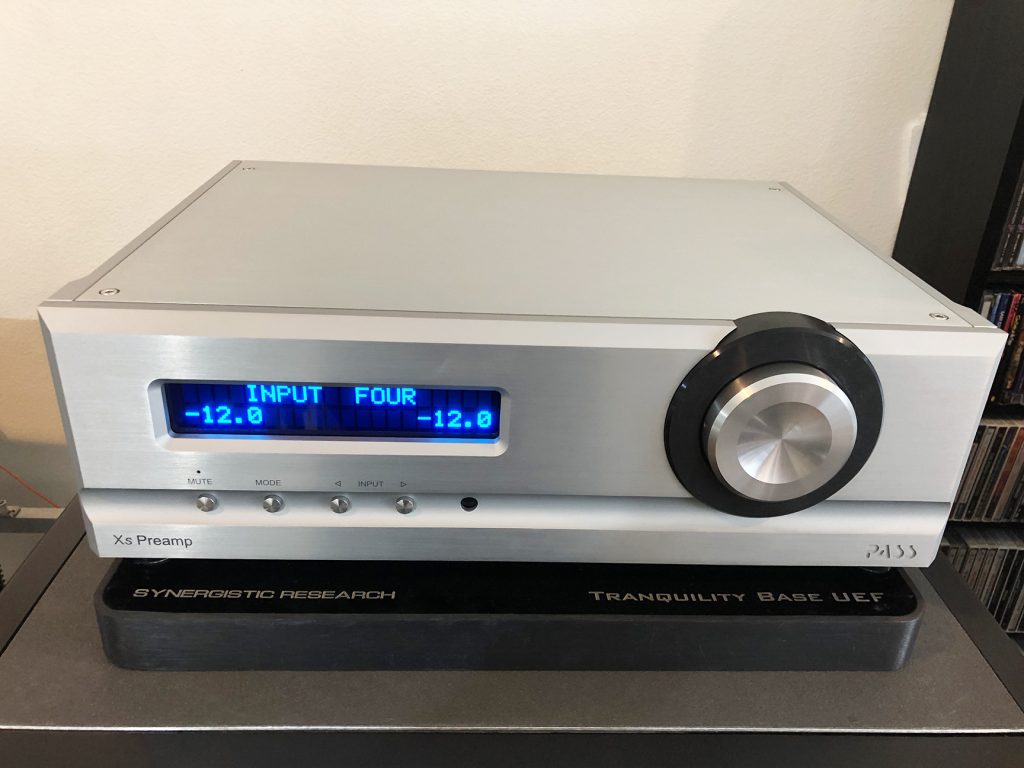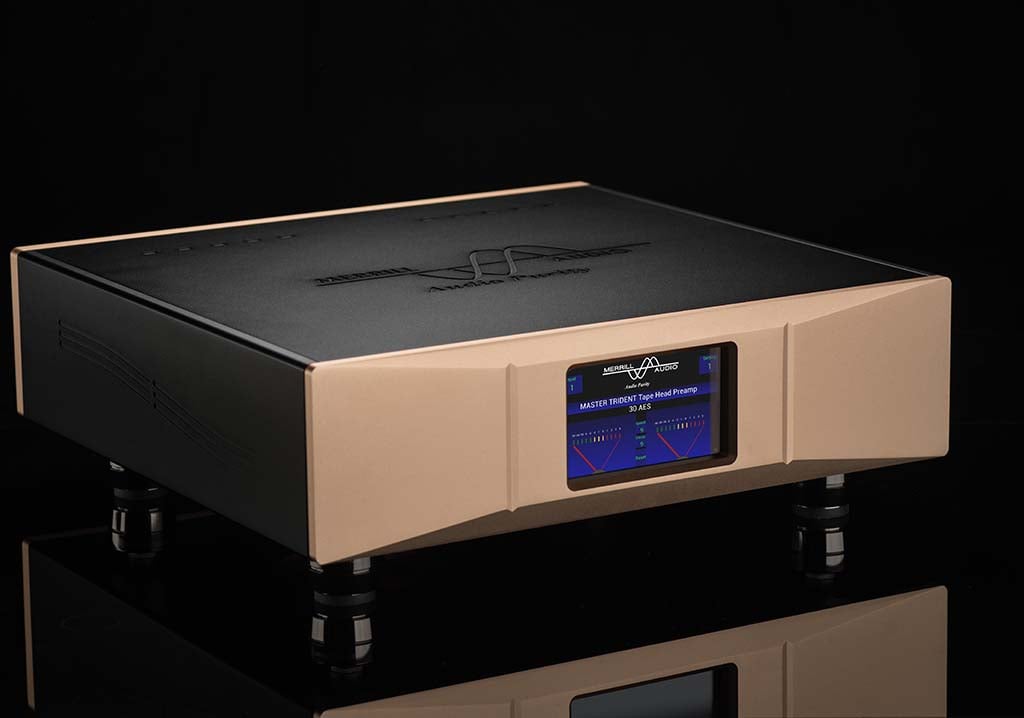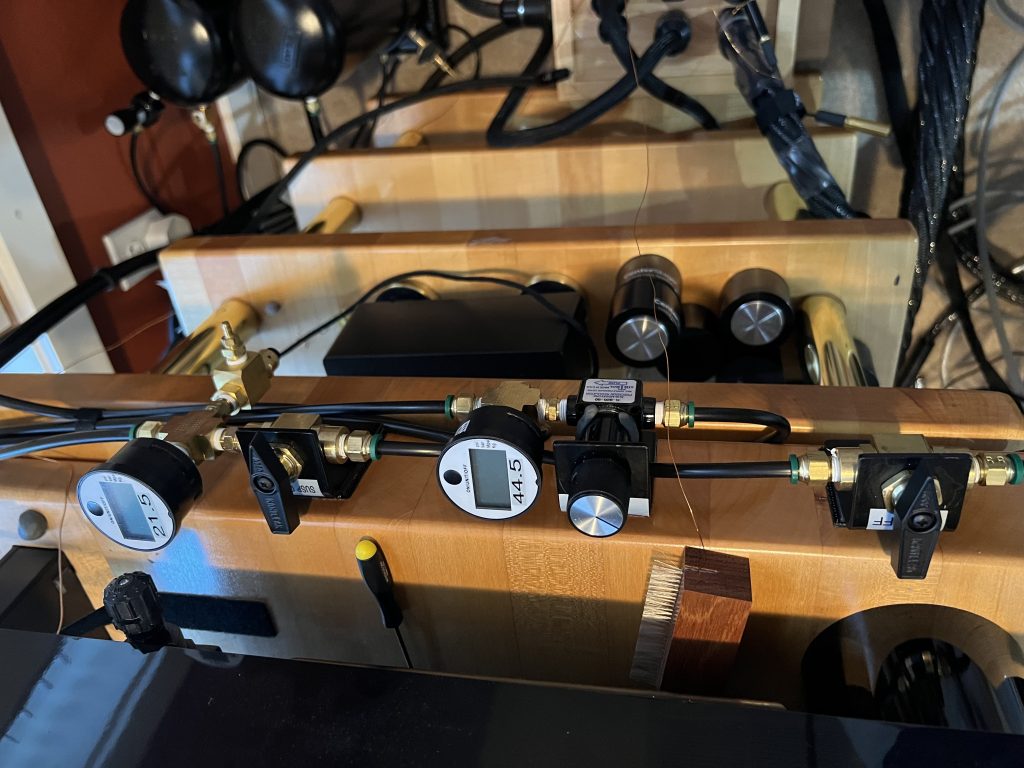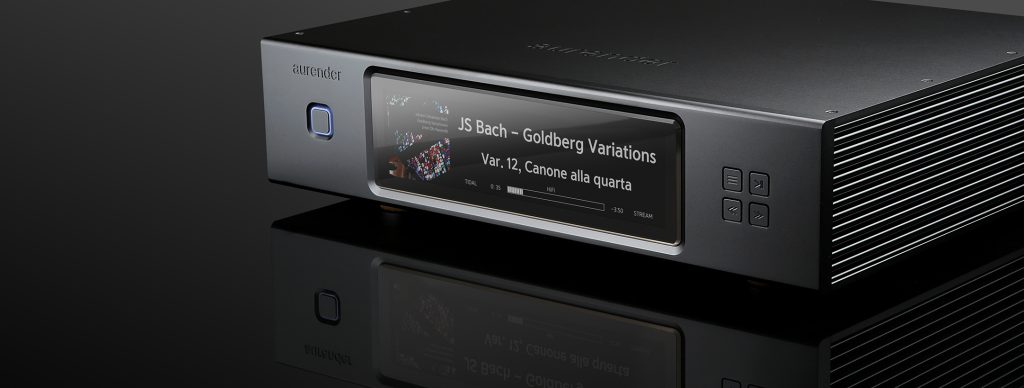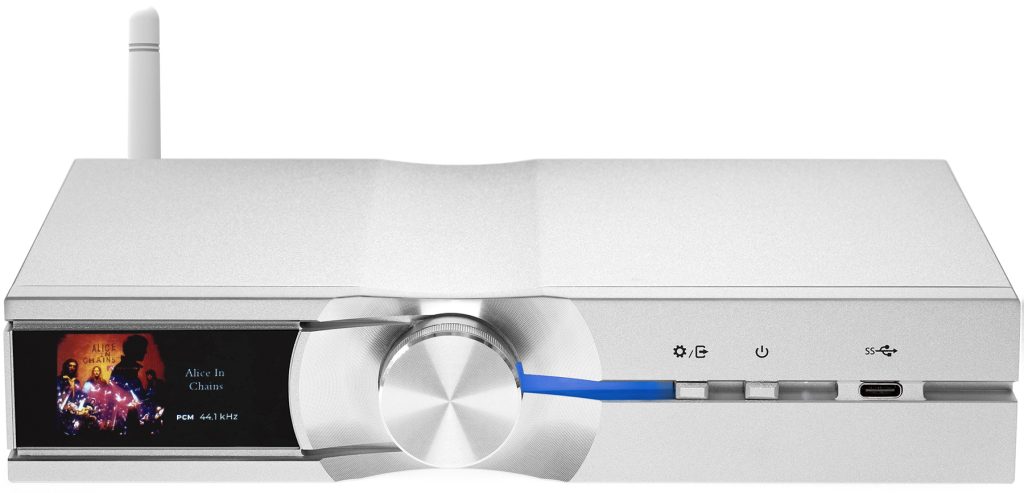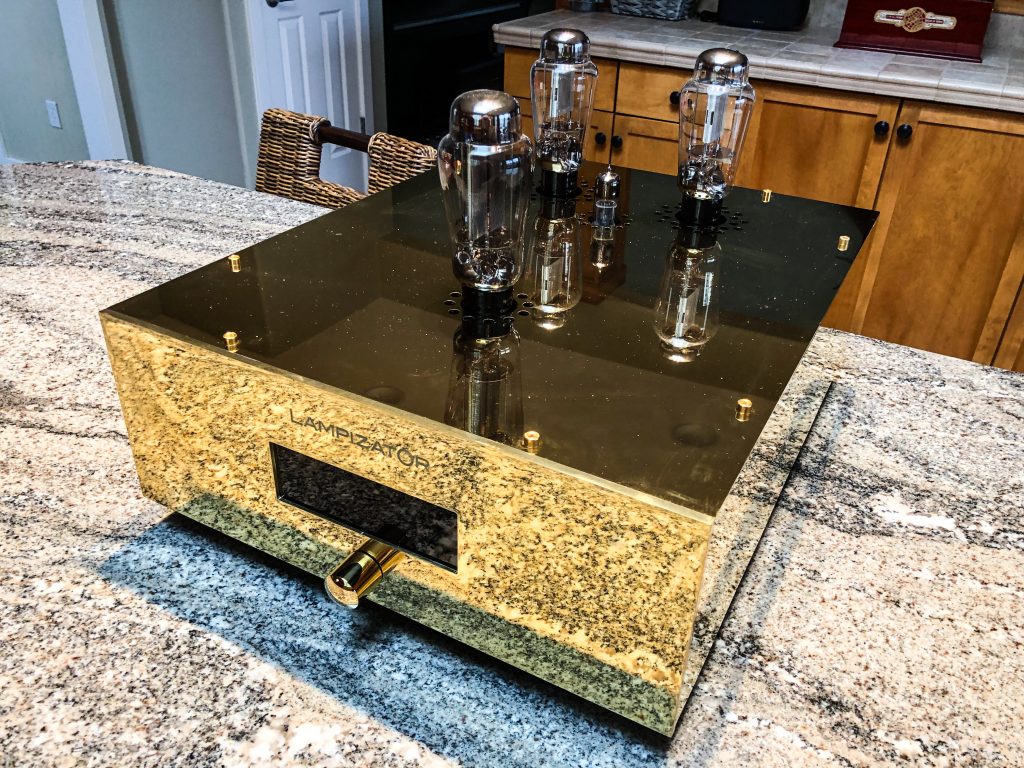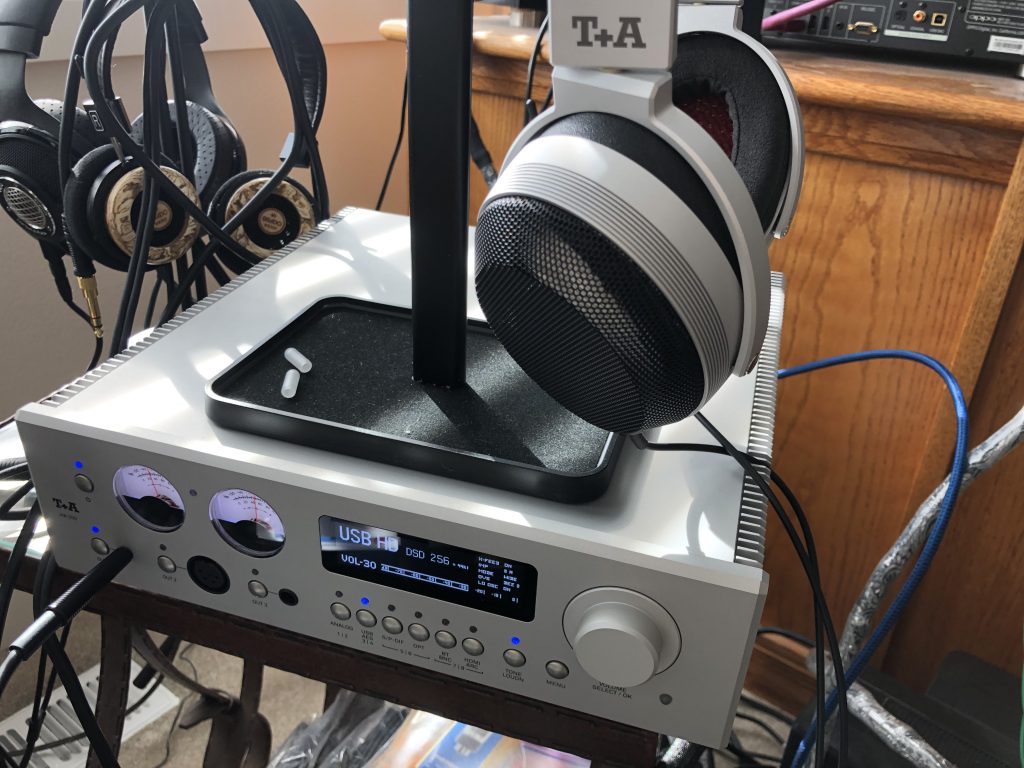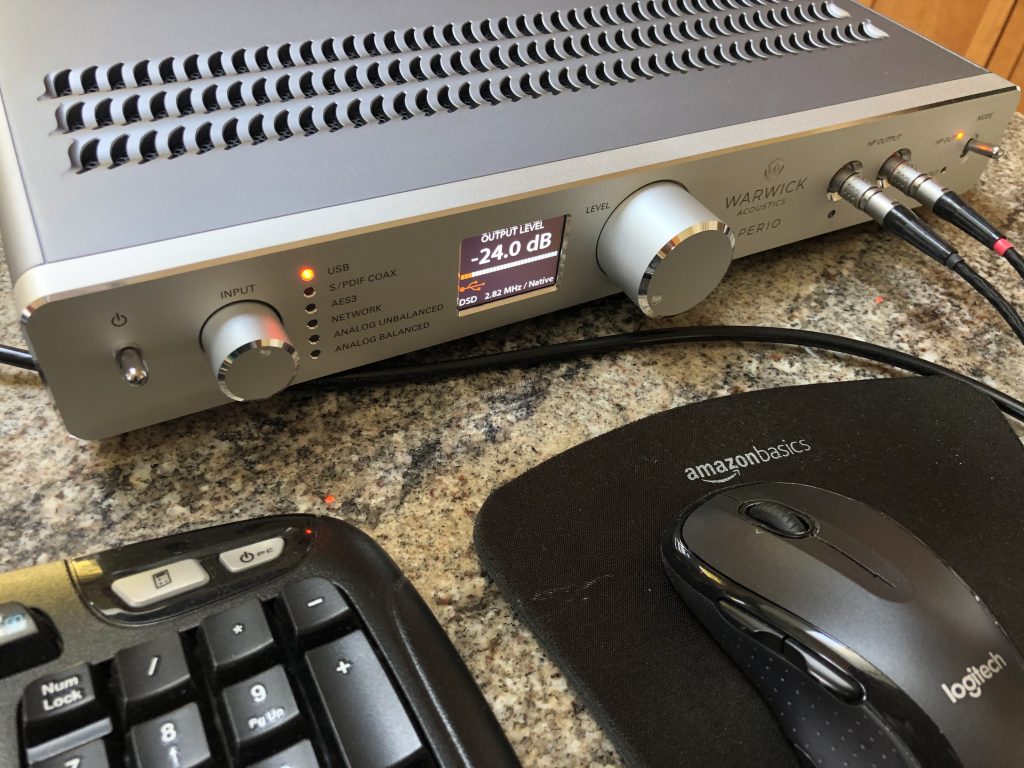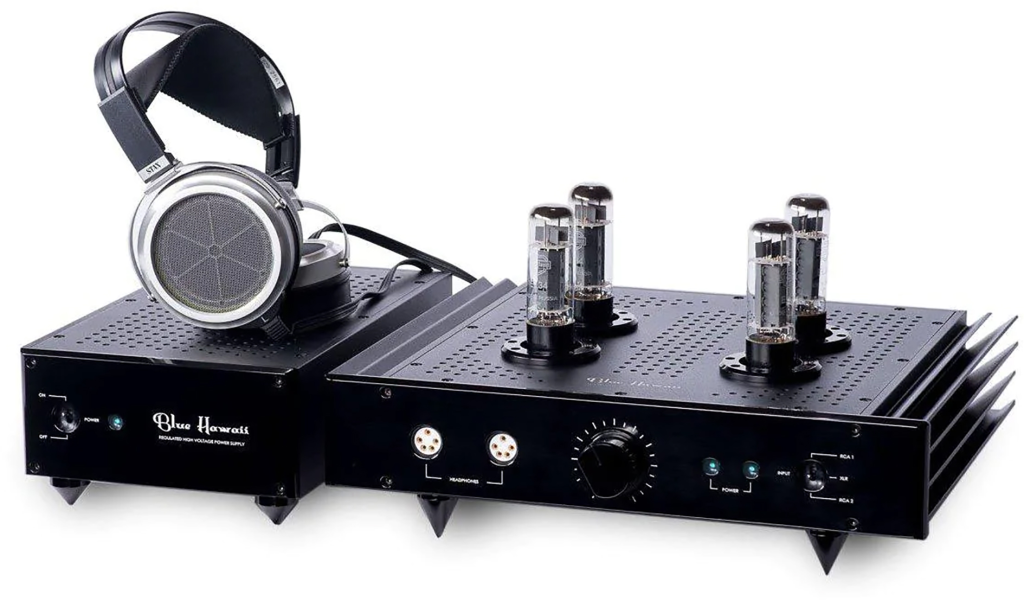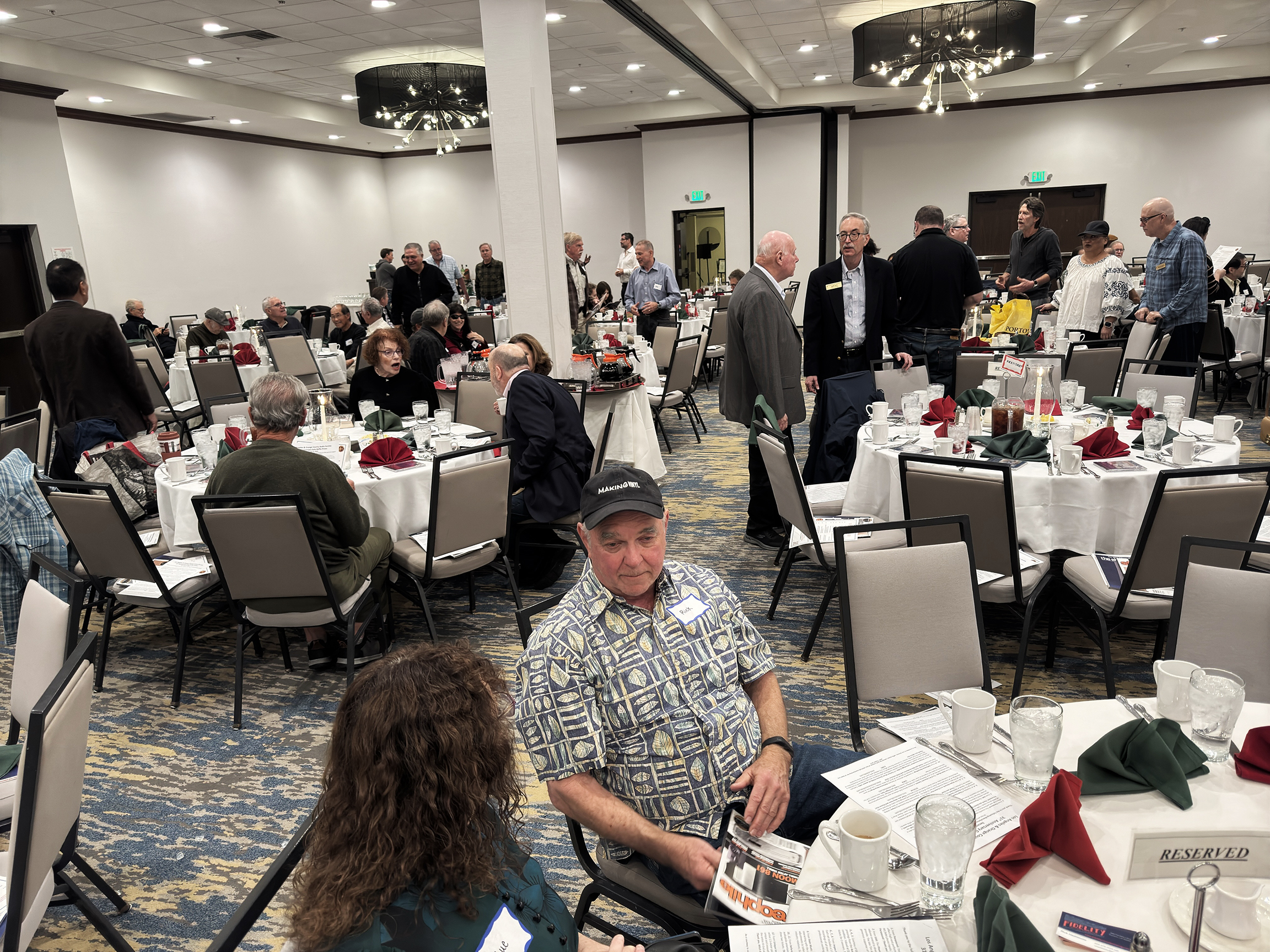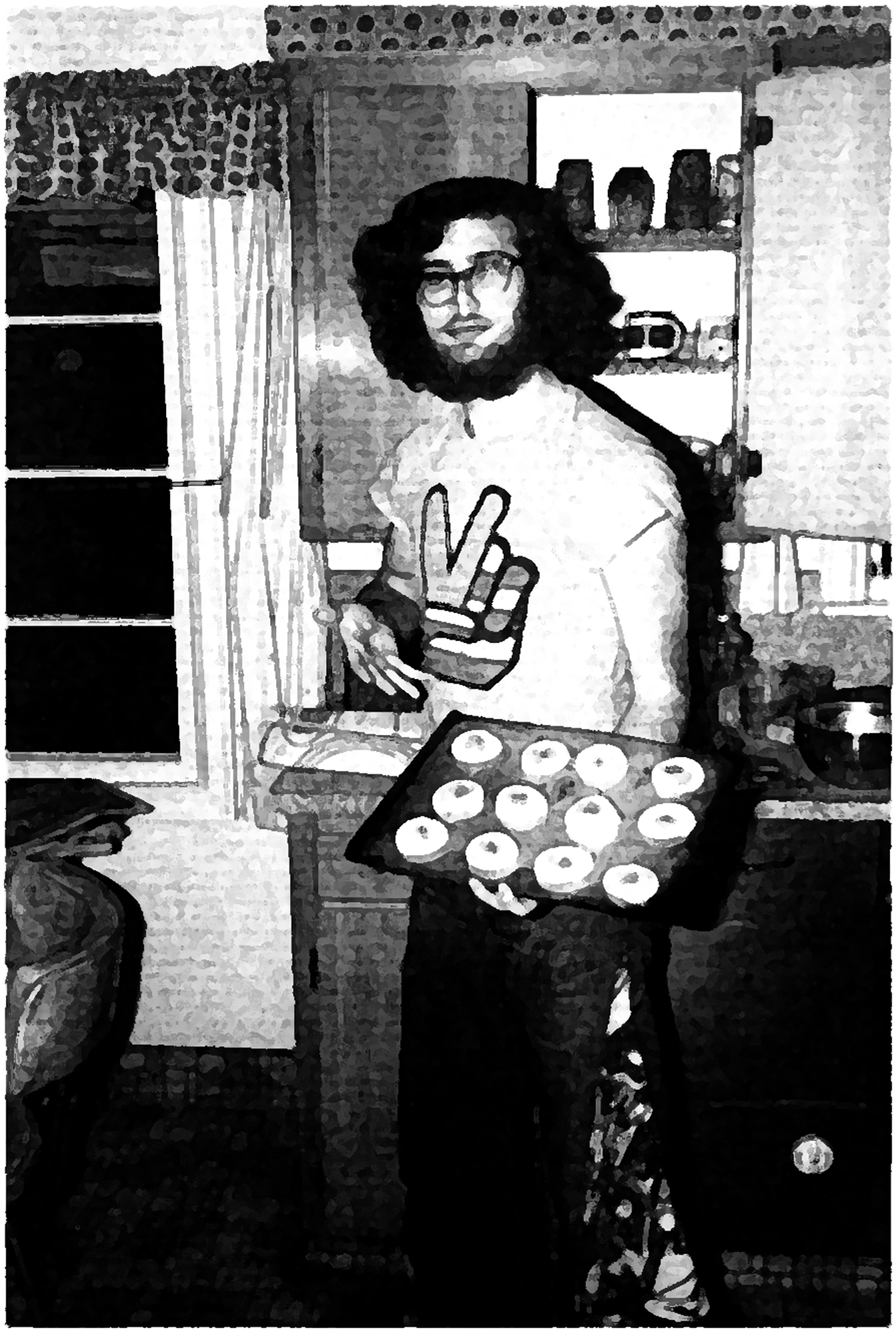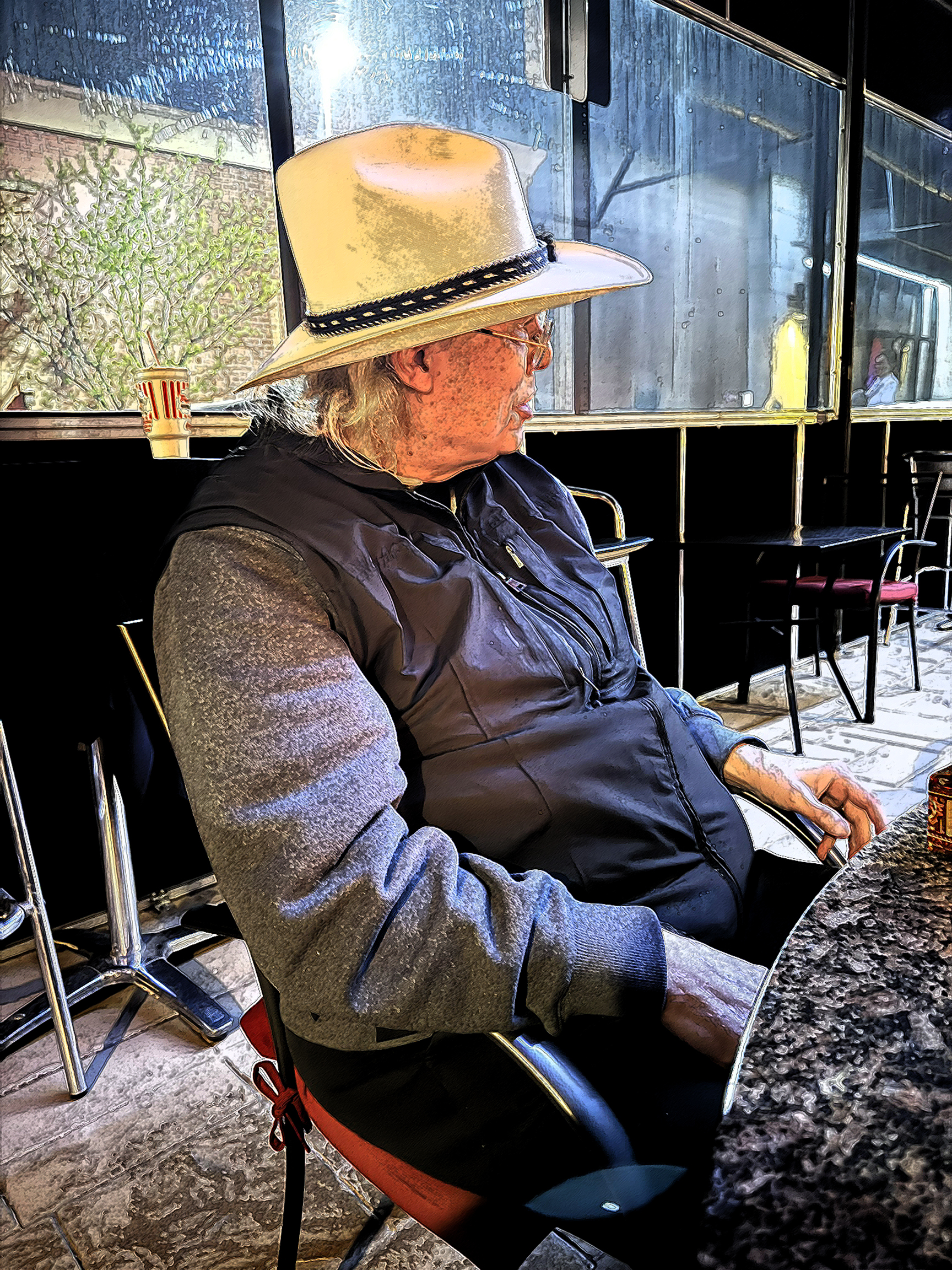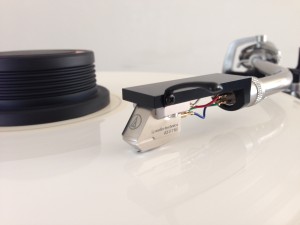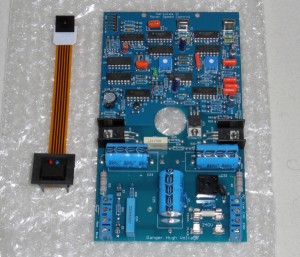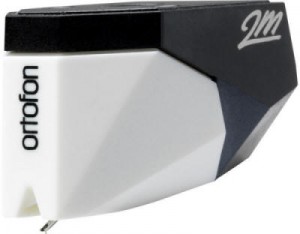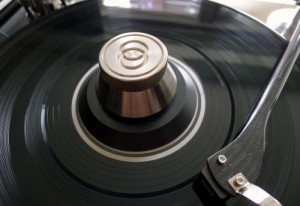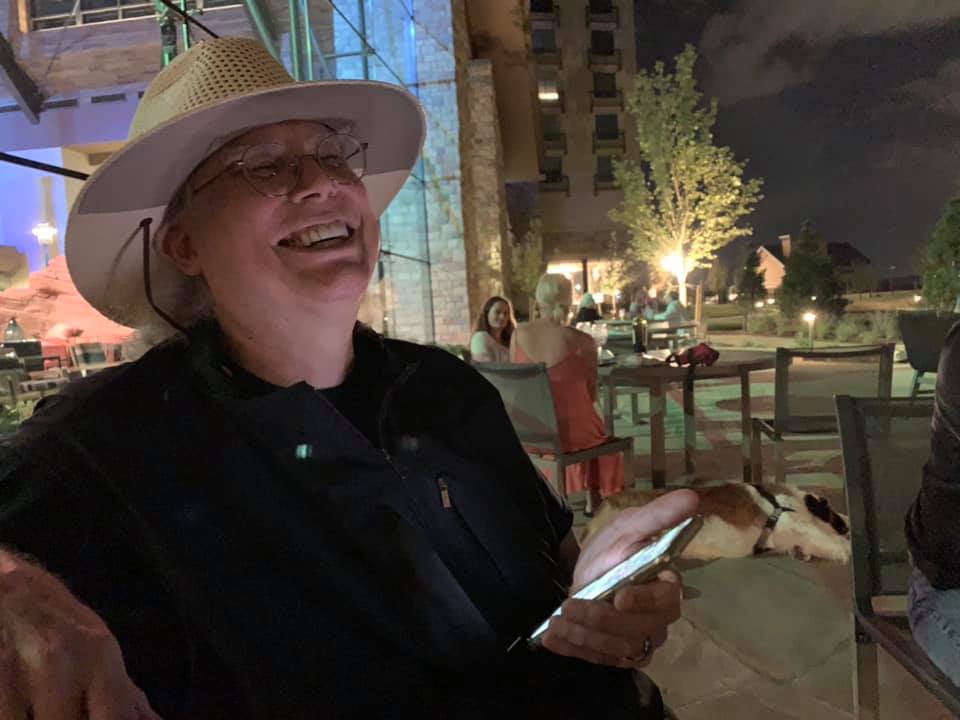
At RMAF, evening cigars, Denver, CO, 2019 (photograph by Scott Hull; image processing by David W. Robinson)
When you do a lot of audio reviewing and show-going over several decades, as I have, you get to see and hear a lot of gear and recordings. Some are good; some are bad; some are ugly. Like life in general, it's not one thing or another…it's a mix.

"Thoughts," painting by Dan Zimmerman
But every now and then you encounter a real wonder. In this case, a turntable system that startled me with its glorious transparency and revealing character.
Which is what happened to me in 2019.
At the end of last year (HERE, in fact), I gave one of my 2019 Positive Feedback Brutus Awards to a threesome of companies whose combination led to a spectacular synergy in reference-level turntable playback systems. That would be the tandem of the Wave Kinetics NVS Turntable/Durand Tonearms Tosca/DS Audio DS Master1 (with the DS Audio ION-001 added later).
I wrote up an extended summary of my reactions at the link above. Please read those before continuing with me here. My intention in this essay is to flesh out some technical details, provide a few more reflections on my further adventures with this system, and bring you up to date on its final status here at PF River-City-and-up-the-Hill. Then you can proceed to the specs listed below.
Specifications and features of the NVS/Tosca/DS Master1 components
For those interested in drilling deeper into this turntable system, I am including the specifics that I harvested from each company's Web site. This will get us through the tech niceties all at once.

Wave Kinetics NVS Computer-Controlled Direct-Drive Reference Turntable Features (photograph and image processing by David W. Robinson)
The NVS reference direct-drive turntable is a long-time companion here at PF Central, and visited me on several occasions for extended stays. Its latest arrival was to act as the well-known-and-trusted platform for Joel Durand's new Tosca gimbal-mounted tonearm, a truly brilliant departure for Durand Tonearms.
Speed Control
- Capable of both 33 1/3 and 45 RPM
- Utilizes a laboratory grade motor control system
- High inertia platter
- Speed accuracy to 1 part per 1,000,000
- Direct-drive system
- Tuning optimized using a 17 degree of freedom tuning model
Vibration Attenuation
- Transfer of floor and airborne vibration is greatly attenuated before reaching the platter and stylus
- A specifically tuned platform eliminates the transfer of floor/stand vibration stimuli such as foot-fall
- Stiffness in the structure – constructed entirely of monolithic parts machined from solid metal billets minimized joints and connectors
- Internal vibration damping system tuned to eliminate transfer of airborne vibration and vibration generated internally (motor & drive train noise)
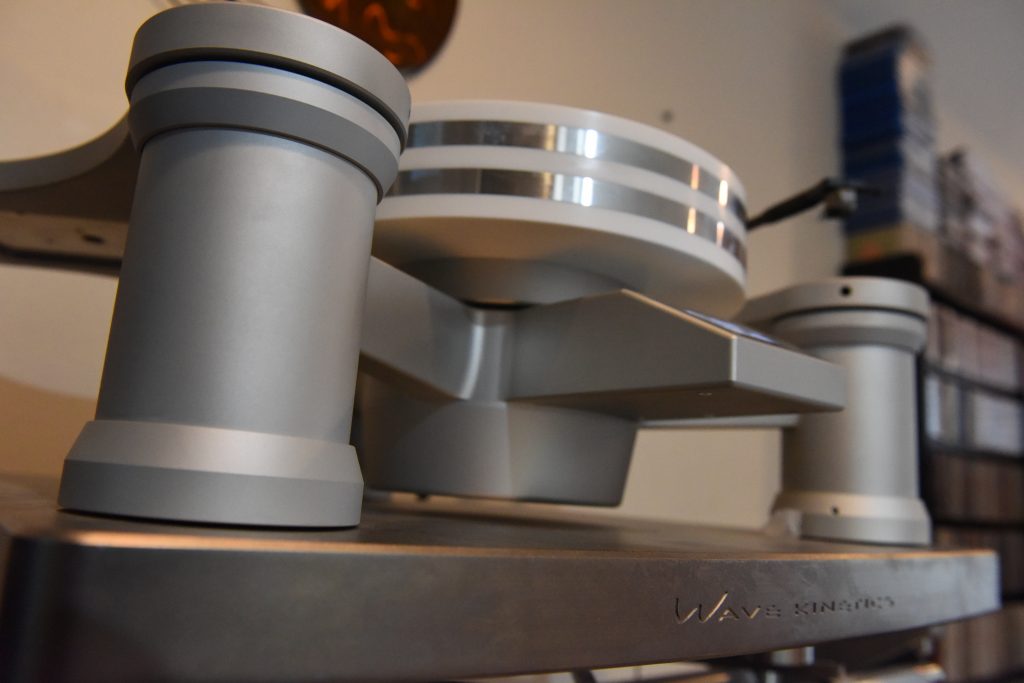
The Wave Kinetics NVS (photograph and image processing by David W. Robinson)
Materials selection
- Body – Solid aluminum billet providing high mass and high stiffness
- Platform – milled from a single large billet of aluminum for unparalleled stiffness. Tuned suspension system using custom viscoelastic dampers, base crafted from proprietary vibration damping material.
- Platter – aluminum/mass loaded polymer. Provides high mass and optimal record /platter interface material.
Married to the NVS was the Durand Tosca Tonearm, a brilliant design and a radical departure to a gimbal-based structure for Joel Durand. I've heard both his earlier Telos and Kairos tonearms…both were killer.
Durand Tonearms Tosca Tonearm Specifications
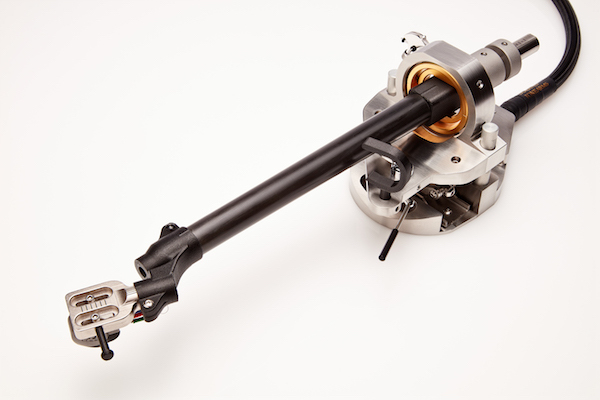
Image courtesy of Durand Tonearms
- Effective length: 263 mm (10.35")
- Pivot-spindle distance: 247.37 mm (Loefgren A geometry).
- Overhang: 15.66 mm (Please see our page on cartridge alignment HERE)
- Offset angle: 20.81 degrees.
- Cartridge mount: 1/2" (12.7mm)
- Mounting on the plinth/armboard is done with 2 x 10-24 (or M4) screws (for metal armboards) or 2x #8 wood screws (for wood armboards).
- Weight of the whole assembly: ca. 3.9 lbs (1.625 kg)
- Bearing: gimbal, hybrid design
- VTA/SRA: fine adjustment with screw activating a mechanism located under the bearing assembly (no need for a hole in the armboard). Range: ca. 18 mm. We provide a cartridge plate (spacer) if the armwand needs to be elevated beyond the range of the VTA mechanism.
- Azimuth: adjustable at the headshell. We discuss the question of azimuth setting HERE
- Anti-skating mechanism can be disabled if desired
- VTF with coupled counterweights: 172, 96, 64 gr. Counterweights are of a special alloy of much higher density than stainless steel. The Tosca™ is a medium mass tonearm, and the combination of counterweights provided with it allows use of most cartridges currently available.
- DIN connector inside the arm base.
- Jig to set the pivot-to-spindle distance provided; no need for a ruler, the jig places the tonearm exactly in the right position
- MintLP arc protractor included
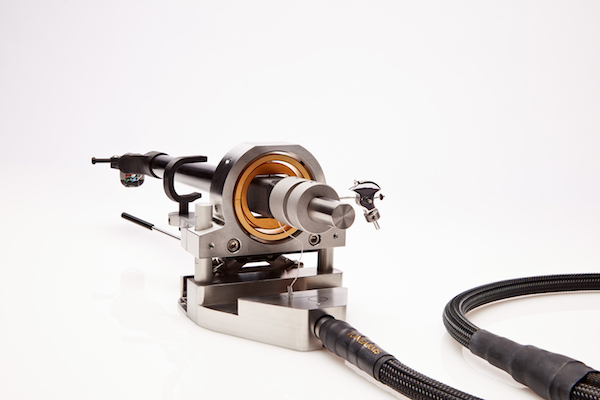
Like our other tonearms, the Tosca™ is a medium-mass tonearm that can be used with most modern cartridges on the market.
DS Audio DS Master1 Specifications

DS Master1 Optical Cartridge
- Signal output: Photo-electric Conversion
- Channel separation: 25db or more (1KHz)
- Weight: 8.1g
- Output signal level: 50mV or more
- Cantilever: Sapphire
- Body material: Ultra duralumin
- Needle pressure: 1.6g – 1.8g (1.7g is recommended)
- Stylus: Micro Ridge
DS Master1 Equalizer for Optical Cartridge
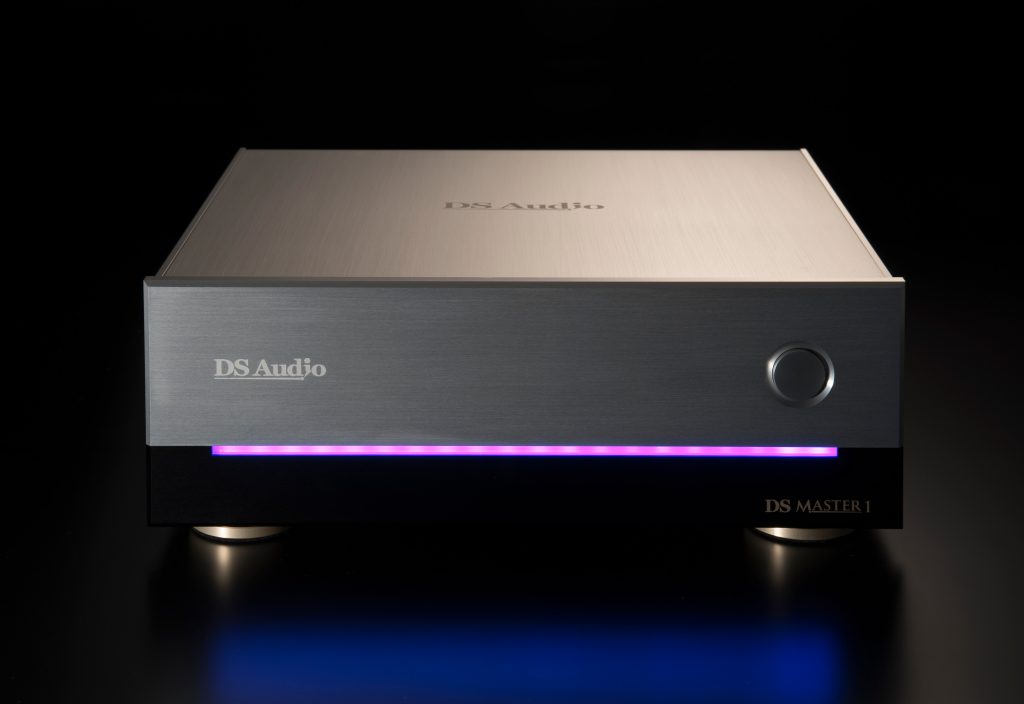
- Output voltage: 500mV (1kHz)
- Output impedance: RCA 120Ω; XLR 600Ω
- Pre amp input impedance: More than 10kΩ
- Input terminal: RCA terminal
- Output terminal: RCA terminal×3; XLR terminal×3
- Size: 43.6cm (17.16") wide×16.1cm (6.34") high×39.5cm (15.55") deep
- Weight: 24.0kg (52.8 lb.)

Onwards...
Thus, the specifications.
But what does all of this add up to?
Well, having heard them at shows and here at home base: What we have here is a gathering of three key components, each of which achieves high standards of transparency, purity, detail, dynamics, and a harmonic and organic presentation of the music. Each component would do well in tandem with other combinations/settings, but the main question for me was how well would they work and play together linked in this combination.
The System Downstream, and Associated…
Systemics.
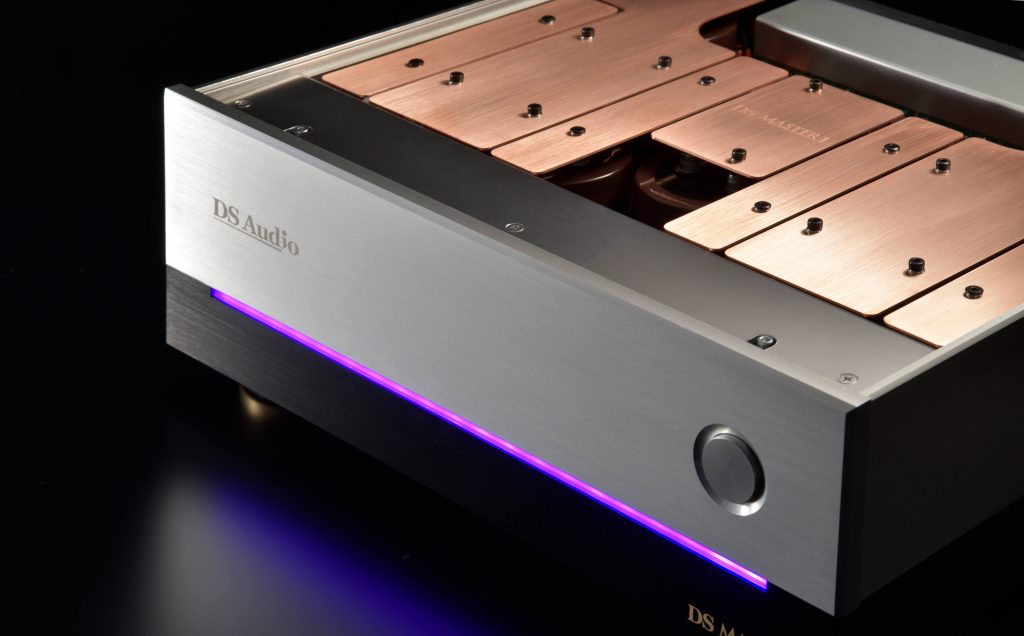
The DS Audio DS Master1 EQ/Phono Amp with lid removed: shielding galore! (image courtesy of DS Audio)
Down the audio stream from the turntable/tonearm/optical cartridge source, the signal flows to the DS Audio DS Master1 EQ/Phono Amp. Unlike many designs of this category, the DS Master1 EQ/Phono is a fully dedicated, no-holds-barred design, built to the specific requirements of the DS Master1 optical cartridge. More on this in a bit.
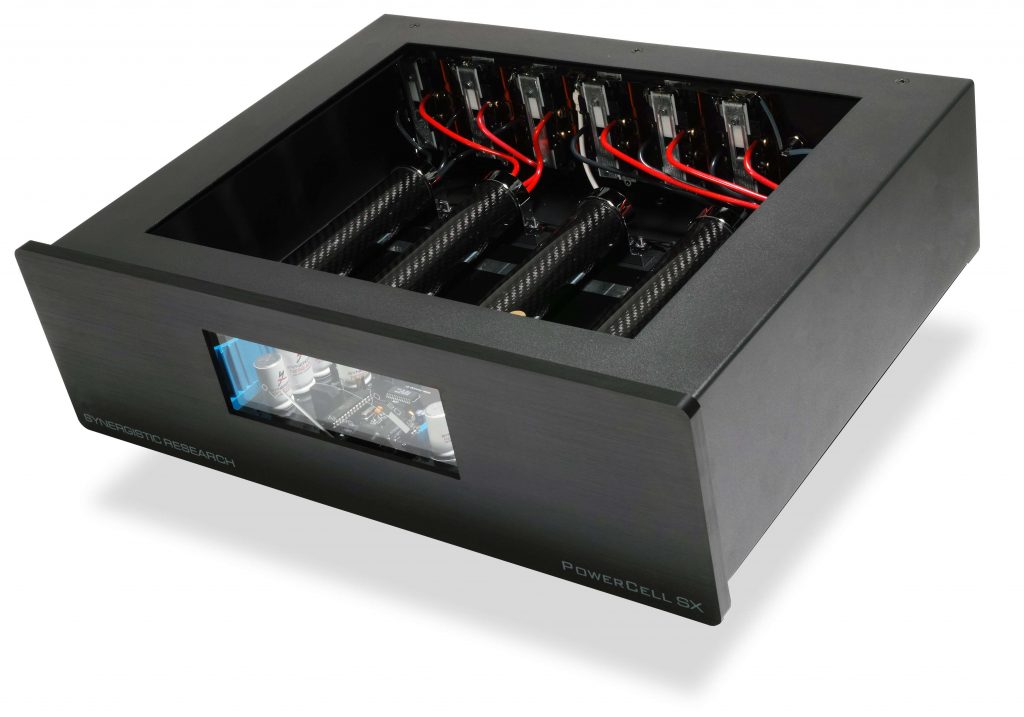
The Synergistic Research PowerCell SX
Thence the output went to the PASS Labs Xs Reference Preamp, and from there on to a pair of the Audionet MAX monoblock amplifiers, all via Synergistic Research's Galileo SX cabling. Power cables to the MAX were likewise Synergistic Research, in this case the Galileo UEF Analog. Power conditioning and distribution was provided by the Synergistic Research PowerCell 12 UEF, later upgraded to the PowerCell SX.
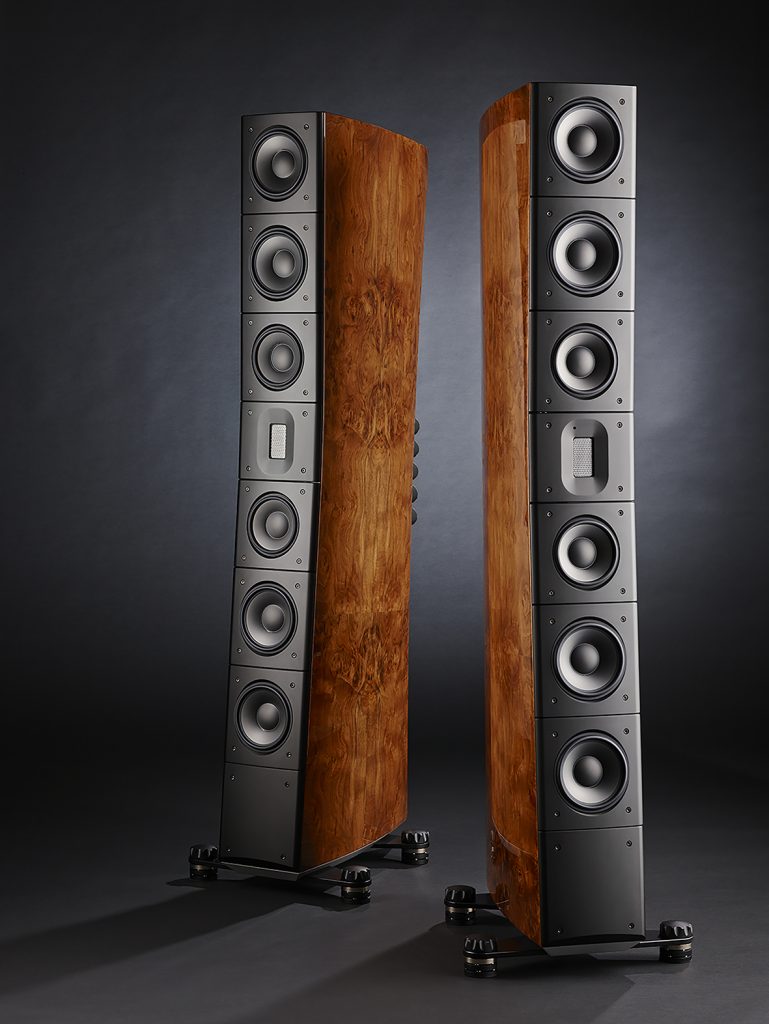
The very impressive Raido Acoustics TD4.2 Loudspeakers (image courtesy of Raidho Acoustics)
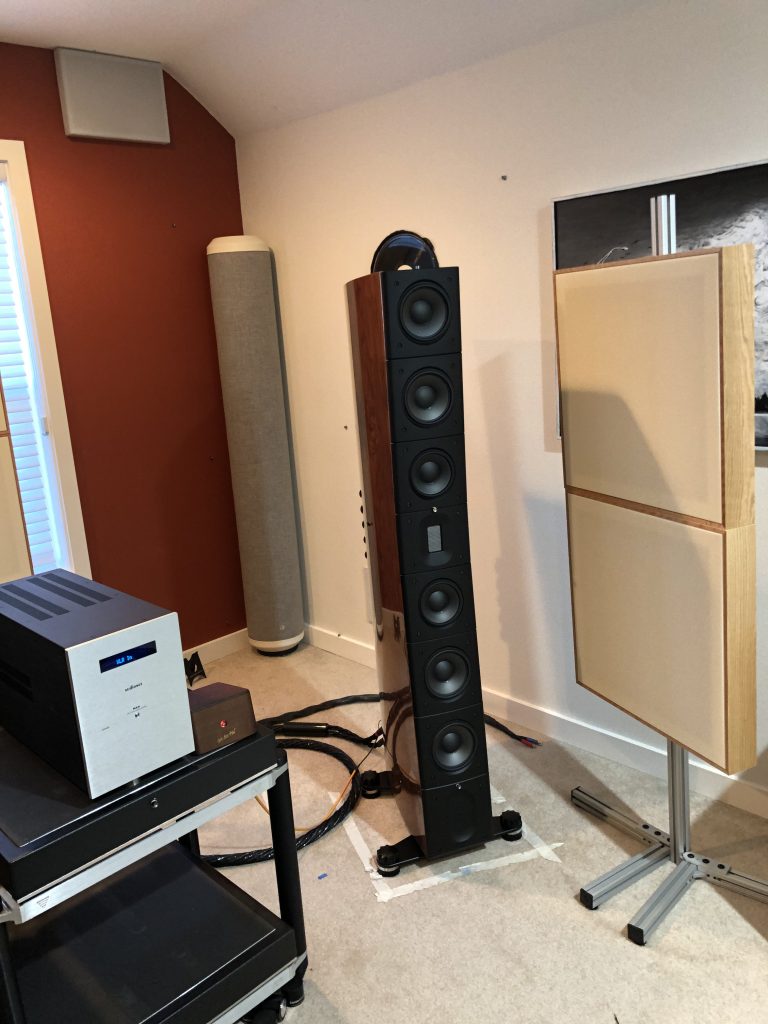
...and in place in PF Central's reference stereo listening room (photograph and image processing by David W. Robinson)
Two different reference-grade loudspeakers were here during the extended review period of the NVS/Tosca/DS Master1 turntable source: first, the exceptional Raidho Acoustics TD4.2 (with Benno Meldgaard upgrades)…

The VIVID GIYA G1 Series 2 Loudspeaker in Ye Olde Editor's reference listening room (photograph and image processing by David W. Robinson)
…and then the memorable-in-every-way VIVID GIYA G1 Series 2. Both of these are very wide-range and dynamic designs, with quite dissimilar ideas about how to go about the job of connecting you to your recordings. And yet, the quality of the experience with both of them converged nicely on powerful presence and transparency, allowing me to triangulate the quality of the turntable system with different transducers.
The setup of the Tosca and DS Master1 was handled by Jonathan Tinn and Din Johnson, both well-practiced, and longtime unindicted audio co-conspirators of mine.
Once in place, I gave the new turntable system a few dozen hours to come up to speed, and then settled down for serious listening.
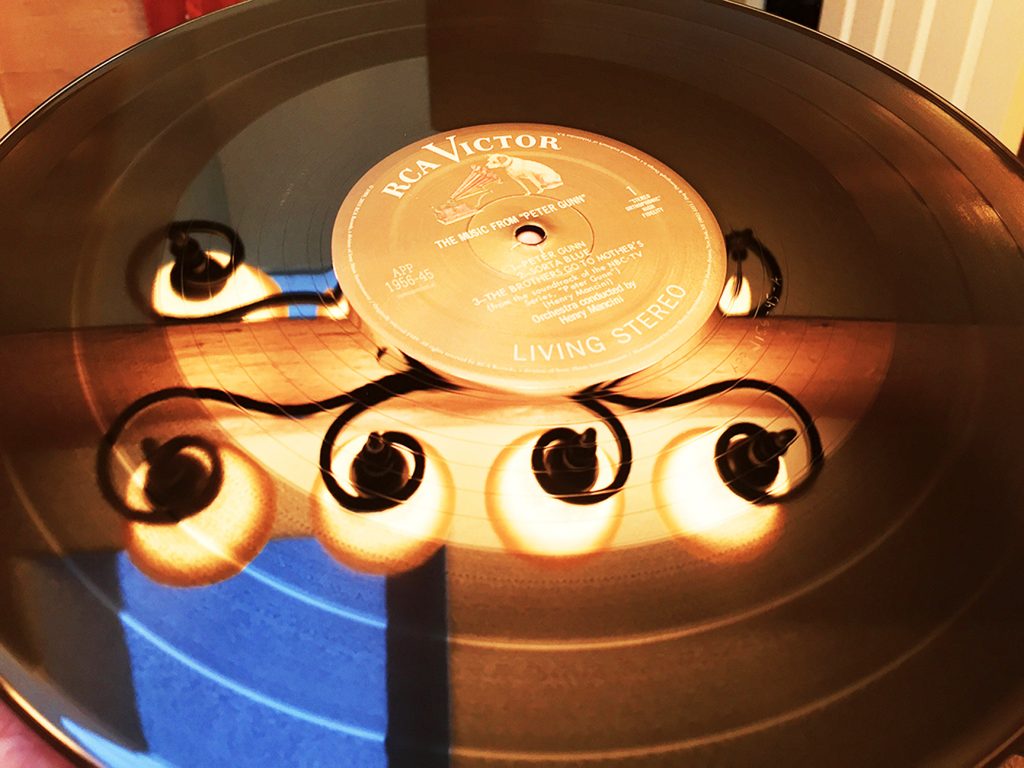
Reflections on an LP, Happy Valley, OR, 2015 (photograph and image processing by David W. Robinson)
The Players in the Cast Summed Up…
All turntable playback involves a system. This stretches from the power supply at one end to the turntable and its rack/suspension/isolation method, the tonearm, the cartridge, the phono amp or pre, and on downstream. This will be more or less pleasant, depending on the synergy of the parts.
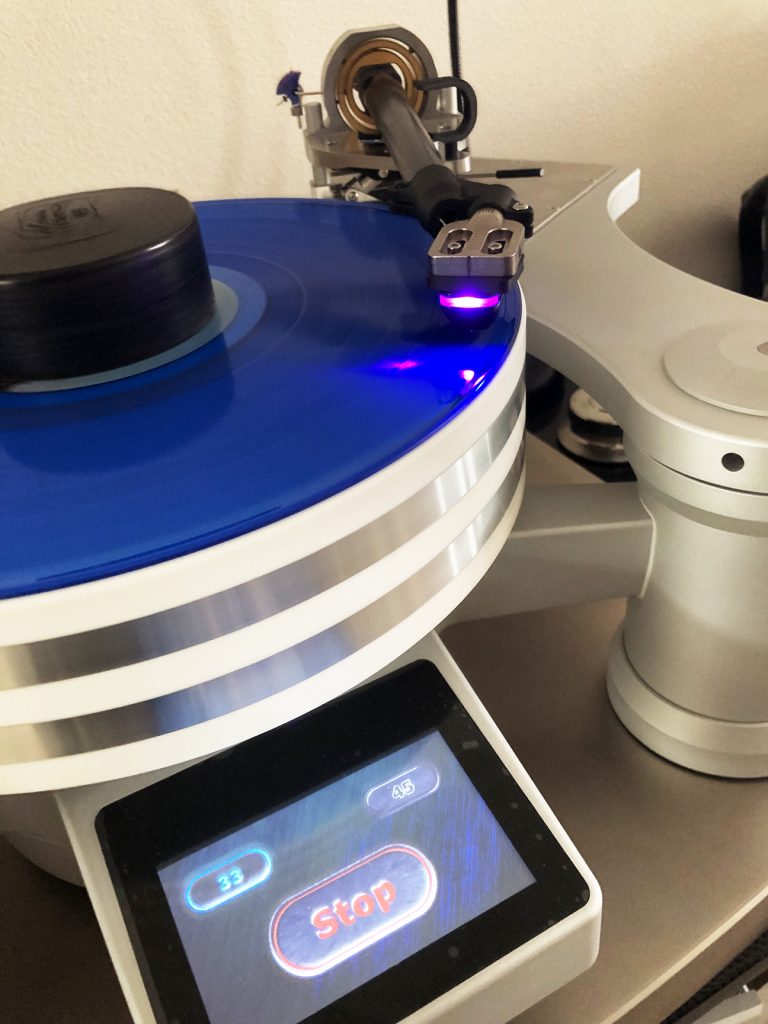
Photograph and image processing by David W. Robinson
The underlying foundation for any LP playback is the turntable and its rack/isolation structure itself. In this project, my old friend the Wave Kinetics NVS direct-drive computer-controlled reference turntable with its Wave Kinetics Isolation Platform provided an exceptionally stable and linear handling of the albums…no second-guessing there. I was completely confident in the NVS. The main rack supporting the NVS and its isolation platform is the Stillpoints ESS Reference Grid Rack. I can rely on Stillpoints to provide excellence in every application.
![]()
The Durand Tosca precision gimbal system, in fresco (photograph and image processing by David W. Robinson)
On the tonearm front: While I had extensive experience with the Durand Telos and Kairos tonearms, the Tosca was new to me. Unlike his two earlier tonearms, which are uni-pivot designs, Joel Durand's newest creation was gimbal-based. As Joel notes on his Web site:
"[The Tosca] is our first gimbal-bearing design and we are confident that we have pushed the boundaries of tonearm design one more time! As usual, the utmost attention has been devoted not only to the design of each single part, but to the materials used as well. Metals were chosen for their specific tonal and mechanical qualities; the armwand is made of a complex construction of damped carbon fiber; the bearing and armwand neck are in a composite material also based on carbon fiber, and the headshell is in nickel-plated magnesium. All these elements were tested over a period of several years in order to achieve the best interaction between themselves and tonal balance."

Image courtesy of Durand Tonearms
One can (and many do!) argue the advantages of uni-pivot vs. gimbal tonearms back and forth, but the general consensus appears to be that perhaps a somewhat greater openness goes with uni-pivots, when properly dialed in, although they can also be harder to get right, and may be a bit too loose and free with their associated cartridges. Gimbal-based tonearms can be tighter and more precise in their control of the cartridge and grooves, but some think that there may be too much grip happening, and that gimbals can be easier to damage. Uni-pivots are fine and free for younger folks, but some older people, or those with motor control diseases, can find it easier to cue a gimbal tonearm. These are gross generalizations, of course, and your mileage may vary. Having listened to both at great length, I find that both designs can be brilliant. As always, superior design and devil-in-the-details execution make all the difference.
(Note that I am not covering the third category of tonearms here: linear-tracking air-suspension tonearms. I have extensive experience with this more complex and expensive domain, due to my very long-term ownership of a Walker Audio Proscenium Black Diamond Level V turntable. When a linear-tracking air-suspension, air-bearing system like the Walker, the ultimate expression of this design in my experience, is in play, you get the best of all worlds. But linear-tracking air-suspension turntables are a huge challenge to get right. Plaudits to Lloyd Walker for his audio artisanship in showing what can be done with this approach.)
In the case of the Tosca, the gimbal design is more complex than I've seen, with three different pairs of connection points to the triple-ringed system. The combination of carbon fiber and various metals, carefully tuned by Joel Durand over several years, has led to an intensely focused and highly controlled tonearm, without destroying musicality. In fact, the musical values seem liberated, and not imprisoned by the degree of stability embodied here.
Having said all of this, my time with the just-under 10.5" Tosca on the NVS turntable has demonstrated to my entire satisfaction that Joel Durand has hit the bullseye with this one. I didn't feel any sense of loss or subtraction from the days of the uni-pivot Telos or Kairos, both of whom I had listened to for long periods of time on the NVS turntable. The Tosca stood right in and shone in its own glory among its brethren.

The DS Audio DS Master1 in action with the Durand Tosca and the Wave Kinetics NVS turntable (photograph and image processing by David W. Robinson)
Which brings me to the DS Audio DS Master1.
The DS Master1 represents the current top of the line in DS Audio's impressive line of optical cartridges, although they have now announced a forthcoming two-box design, the Grandmaster. (It really looks amazing, but it isn't in heavy production yet, so far as I know.)

Garth Leerer at RMAF 2019: portrait by David W. Robinson
I had started to hear DS Audio at shows, in rooms hosted by Garth Leerer of Musical Surroundings, where they caught my attention. This was underlined during a visit with Nelson Pass at his place in Sea Ranch, CA, when he played some great LPs on his DS Audio-equipped turntable in his workroom listening space.
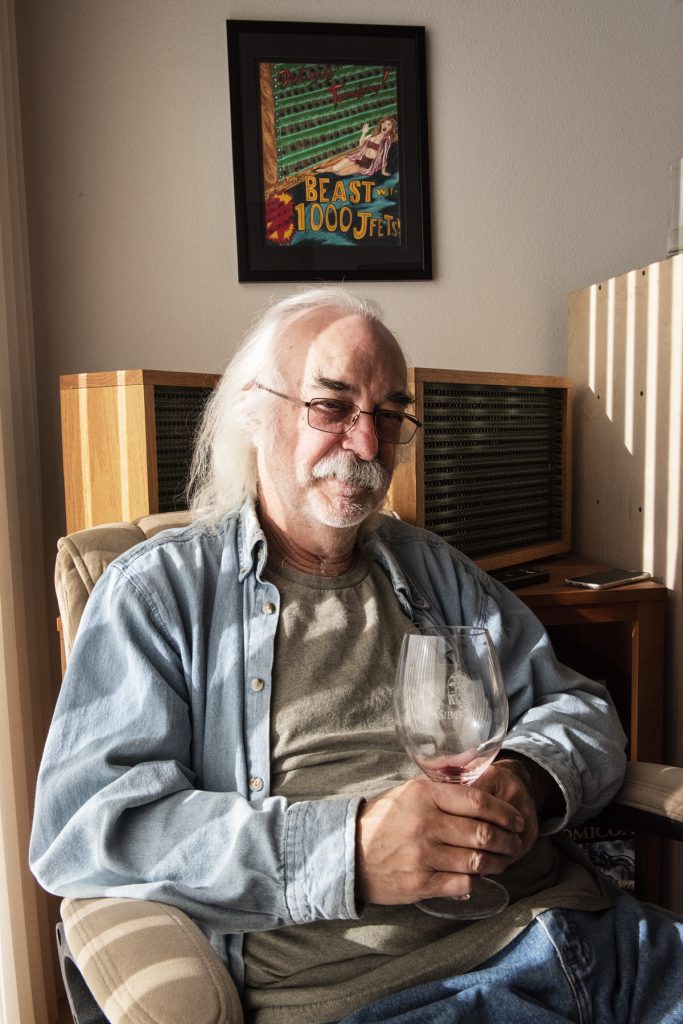
In the listening room with Nelson Pass and his DS Audio-equipped turntable, Sea Ranch, CA, 2018: a portrait (photograph and image processing by David W. Robinson)
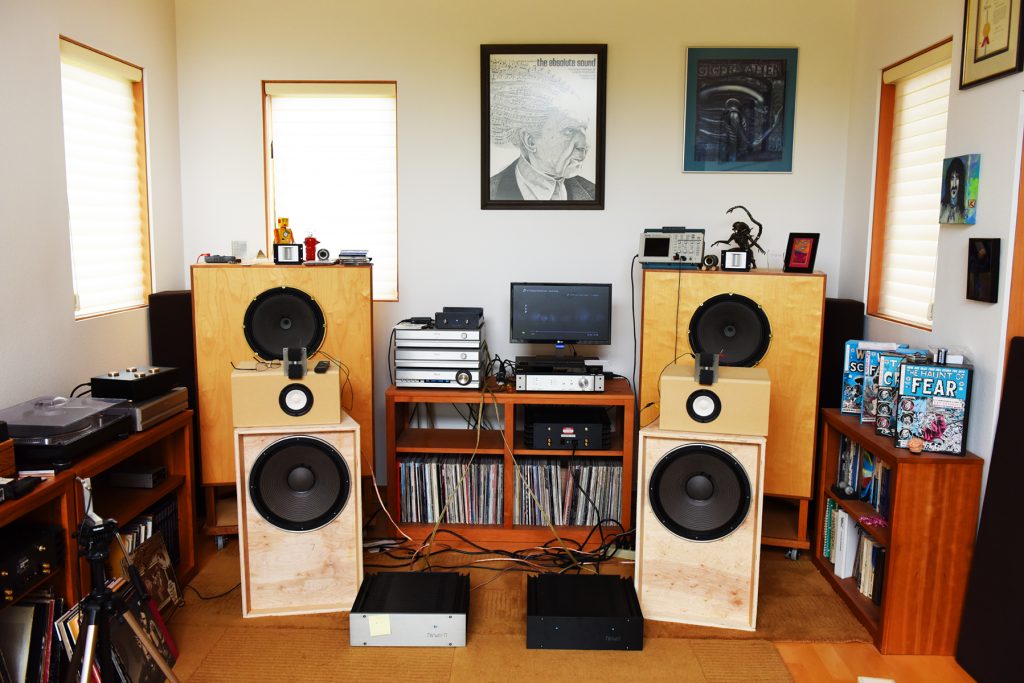
Nelson Pass's sanctum sanctorum: His working lab for speaker crossover research and such…
The results were knock-out, and confirmed that I really needed to get DS Audio's reference system, the DS Master1 in for review at PF Central.
It took some time to arrange the review sample of the DS Master1 system…for system it is…and then there were delays with the actual deployment of same. By the time it arrived, I had to wait for another turntable/cartridge project to clear out the way. This took a few months. (The logistics of reviewing in a busy setting like hereabouts can get pretty complicated.)
But once everything was in place, I went into extended and very serious listening.
The Sound and the Gob Smack: The Groove and the Glory!
Once the turntable system was in place and dialed in, on came the LPs. A lot of them…and then more and more. No introduction is (or should be) necessary for these, which are just a few key albums that I used for evaluation. You may find these a useful guide to LPs that you should add to your collection, if you don't have them already.

The RCA Living Stereo reissue of Stowkowski Rhapsodies, reissued wondrously by Analogue Productions/Acoustic sounds needs no introduction…or shouldn't. Incredible dynamics, wonderful hall sound, deep and rich growly bass strings, brilliant presentation, this has been a standard reference for me for many, many years. The NVS/Tosca/DS Master1 shone in glory with this LP.

Bobby-o Dylan's Blood on the Tracks is one of the really great albums from this prophetic poet-songwriter. MoFi's Ultradisc One-Step Pressing process gives us an LP that gets remarkably close to master tape quality sound. This is the sort of LP that the NVS/Tosca/DS Master1 was made to explore and reveal. Certainly, I heard details that I had never noticed before, which indicates to me the extraordinary transparency of this tandem.
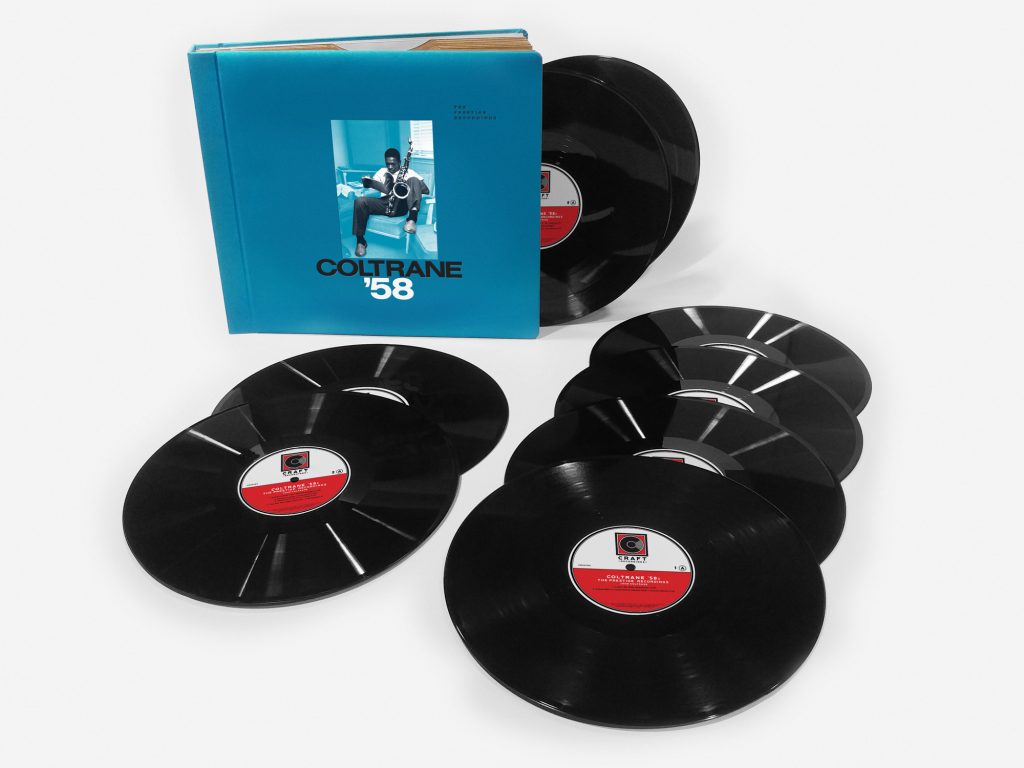
What can I say? The Coltrane '58 set of LPs reissued by Concord Craft Recordings is a fantastic achievement, very well transferred in this reissue set. I'm pleased with the sense of immediacy and presence in these grooves, which the NVS/Tosca/DS Master1 reveals with stark beauty. Jazz lovers…this is a real blessing.

I purchased the 3-LP complete version of this tour de force by Ryan Adams. Live, raw, and really well recorded, via the NVS/Tosca/DS Master1 you have a powerful sense of the music, the man, and the moment there in Carnegie Hall. The haunting sense of space and the symbiotic relationship between the artist and his audience. With this playback system, I found myself feeling more like "mic feed" than "master tape" with this recording…a great thing. Crystalline, organic, detailed…nothing missing, nothing added.
You can sample this online to see if this is to your taste; if so, then jump and get it! It's a essential recording in your collection.

Steven Wilson is a prodigious artist in the world of progressive rock and alternative. His name has been attached to a number of magnificent remastering projects (e.g., the Yes discography, or his work with Jethro Tull reissues), and his eponymous work is a wonderful collection of albums that I listen to all the time. Not to mention being the creative heart of Porcupine Tree, a group that if you haven't heard them, you really should.
The music in IIII½ drifts from haunting to melancholic to driving, with the sort of prog-alt drive that really sends me soaring. Wilson is exceptional in the studio, at both ends of the line. The quality of the audio engineering and mixing here is outstanding via the NVS/Tosca/DS Master1…truly killer.
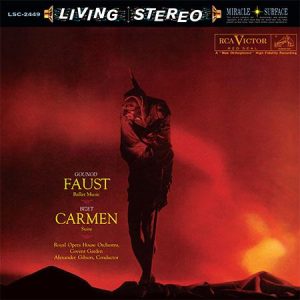
I don't need to say anything about why I would use this Analogue Productions 200 gram/45 RPM reissue of the RCA Living Stereo of Carmen/Faust by Gibson and the ROHO. A smashing performance, filled with verve and richly organic music, this LP is a real analog workout from top-to-bottom, side-to-side, and forward-back. And if you don't love Carmen, check and see if your soul dropped out of your pocket and got lost somewhere along the way.
Needless to say, the NVS/Tosca/DS Master1 passed with flying colors. I was impressed.
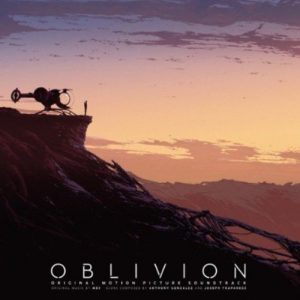
Something different, here.
This sci-fi movie really impressed me, and I was taken by the music. It took me months to find one of the very limited-edition alternative-vinyl reissues of the Oblivion soundtrack, and a pretty healthy number of dollars to obtain it. In fact, my first two purchases turned into returns, as the LPs were flawed/mis-graded (a way-too-common problem from some sources). A real pain in the hindmost parts.
But when I did finally score one…ambrosia!
The NVS/Tosca/DS Master1 exposed the Oblivion soundtrack LP, revealing it to be darkly brooding, immensely dynamic, with basso profundo that reaches all the way down into the netherworld. This soundtrack album is incredibly moving to me, and I have returned to listen to it again and again.
It also gives a serious system workout. Those of you looking for a break-in album…this is certainly one of them. (It's also available online for those of you who prefer to stream, although I haven't seen it at higher resolutions than 44.1kHz/16 bit, unfortunately. This one deserves at least 96/24, and 192/24 would be even better. No DSD, alas.)

Speaking of break-in albums: here's another. It's the soundtrack LP for the movie Arrival.
Profound bass, and some slamming dynamics…watch your volume.
Strange and disorienting music…suggesting aliens, alienation, with notable mystery and tension. All were rendered with extraordinary palpability by the NVS/Tosca/DS Master1. Impressive, and an immersive listening experience. This LP should be in your collection, and is also available via streaming online.

My boy Beck! His album Hyperspace!
Ever since I heard his smash hit "Loser" back in the ‘90s, I have been intrigued by Beck's creativity, his energy, his drive…but also by his shape-shifting ability to grow and develop completely different vibes and sounds. Sea Change, which I have on LP and SACD really knocked me out, as he found a haunting, melancholy groove that embodied how much he had developed since the days of Odelay. 2014's Morning Phase is a perennial favorite here, too…again, major chunks of reverie.

But this album, Hyperspace, presses out into new ground, with a mix of rhythms, moods, touches of funk, and brooding all tossed in. The title cut almost sounds like it could have been used in the soundtrack of the original Blade Runner. Musical eclecticism in spades! Which is why this album never gets old for me.
The LP is made to shine by the NVS/Tosca/DS Master1. This is certainly a modern mix, but the emotional feeling of the recording is launched at warp speed straight to the heart with this playback system.

Well, of course.
No extended commentary necessary. Just apply the gist of my comments above to this utter reference-level recording reissued by Analogue Productions and featured by Acoustic Sounds, and you have it. The NVS/Tosca/DS Master1 reproduced this LP with utter authority and clarity. Mountaintop sonics, for sure…with transparency being the gatekeeper over all.
Enough said.
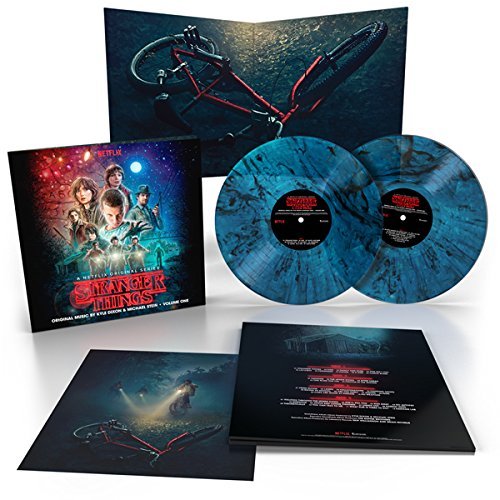
If you're not familiar with the soundtrack to Stranger Things (Season 1), then what are you waiting for?! This gothic sci-fi horror, throwing us back into the 80s, has fascinating music for the journey. It's captured on this limited-edition colored vinyl set, which sounds truly delicious. Darkly dynamic, creepy, and memory-inducing (for those of us who grew up loving sci-fi/horror), this is delightful stuff.
The opening track…the all-too-short theme song…is worth the price of admission all by itself.
Moody, evocative of being young in America in the 80s, this is a Proustian album for me.
Sounds fantastic on the NVS/Tosca/DS Master1, in every way.
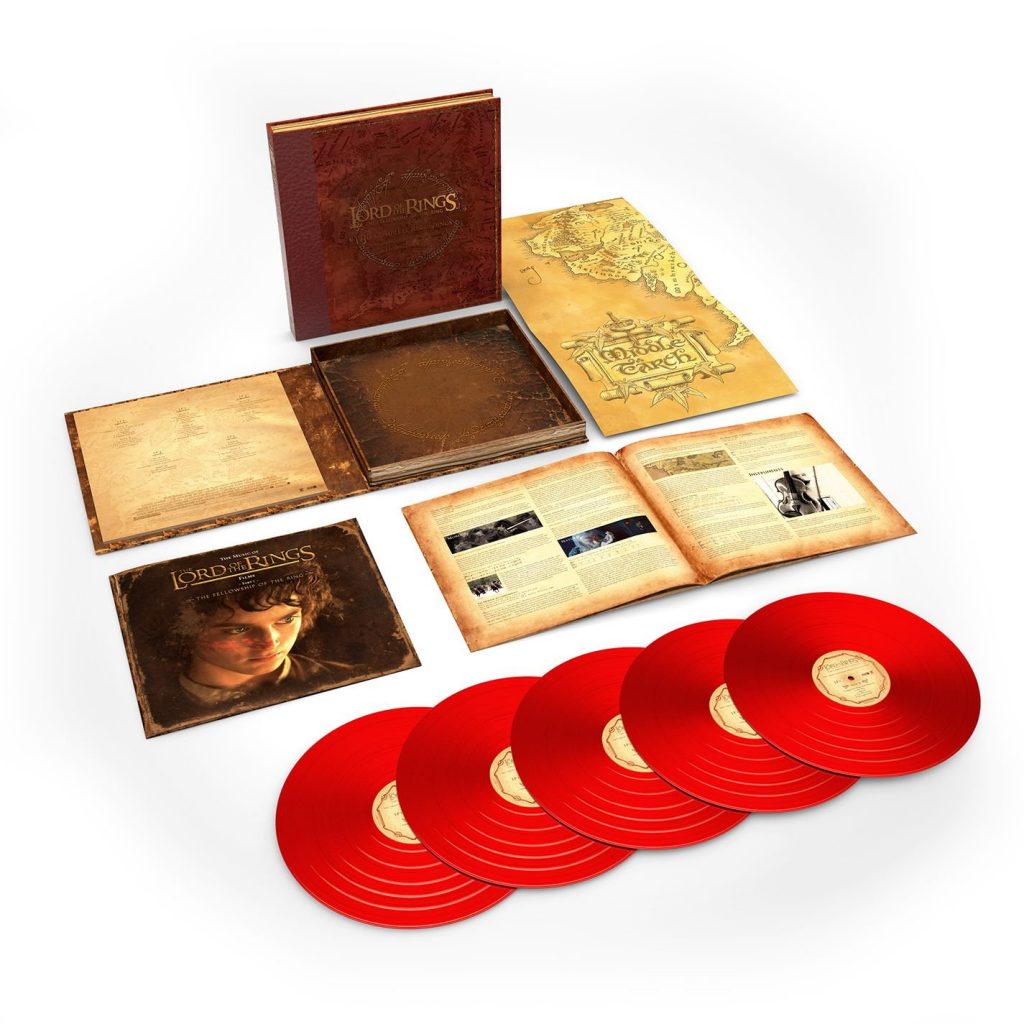
Here we have the limited-edition 5-LP box set on colored vinyl of Howard Shore's magnificent soundtrack for The Lord of the Rings: The Fellowship of the Ring. This is the complete score for the first movie in the cycle. (There are a second and third box set on colored vinyl, as well, which we have also in the library here at PF Central). It's a monumental achievement of composition, Wagnerian in sheer mass, one that I never tire of.
I imagine that most everyone in America has heard the soundtrack, at the movies if nowhere else. But the complete scores of Shore's immense work on LP are simply phenomenal, and must be heard on an excellent turntable system to be fully appreciated. And certainly the NVS/Tosca/DS Master1 combination is fully up to the dynamic range, the movement from dark reflection to soaring triumph, and the detail represented by this box set. How very satisfying to hear this beloved music in such crystalline, clear glory!
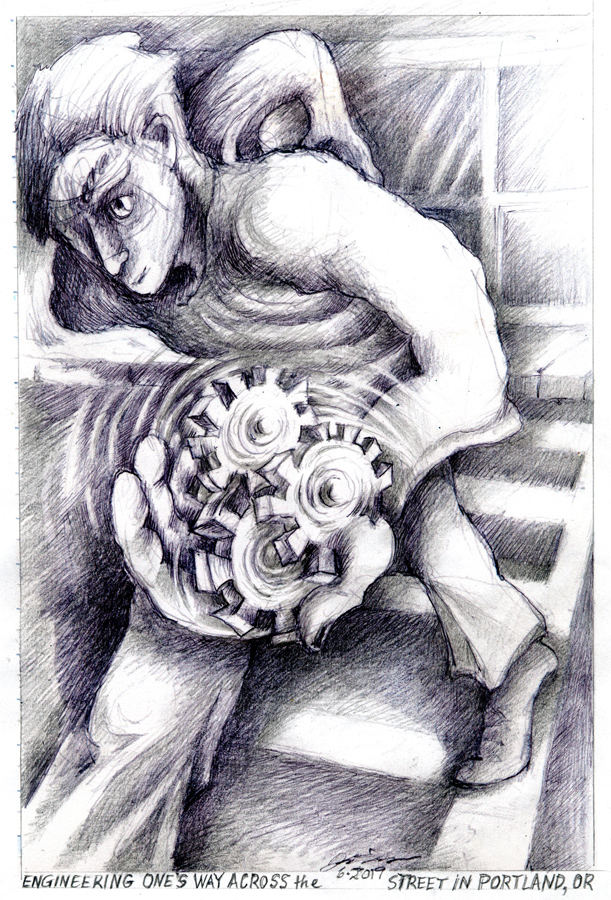
"Engineering One's Way Across the Street in Portland, OR" dated June of 2019 (drawing by Dan Zimmerman)
There were, of course, countless other LPs from our library of thousands. These are simply some that come to mind as I write these reflections.
Speaking of which: In every case with the NVS/Tosca/DS Master1 combination, I found all major categories of high-end sonic performance to be at the top o' the heap for me. The incredible engineering represented by all three of these designs, supported by their underlying cast, and their symbiotic bonding into an extraordinary synergistic block, were break taking.
Transparency: The king of the audio virtues, in my book. It's the gateway to all other audio qualities, since it determines how clearly they may be perceived. In this case, the transparency was outstanding, obviously the best that I've experienced in our listening room. The music was crystalline, clean, and without the sort of veiling or coloration that happens too frequently in the reproduction of music. The clarity of LPs in our listening room was startling, actually, powerfully confirming everything that I had heard at shows and in Nelson Pass's room.
Groove noise? What's that?
Really.
Dynamics: The NVS/Tosca/DS Master1 were world-class in their ability to render a massive dynamic range with LPs. Given what I've already said about the transparency of this combination, this should surprise no one. The subtraction of groove noise accomplished by the DS Master1's optical conversion system dropped the noise floor significantly, leading to an improved impression of dynamics. The Tosca's firm control undoubtedly contributed to the maintenance of focus during even the most driving moments
Detail: Naturally the level of detail rendered by the NVS/Tosca/DS Master1 was absolutely front-rank. For the reasons already mentioned, even the tiniest, most nuanced aspects of recordings came forward to be recognized and appreciated. Which I certainly did.
Soundstaging: Right on. Both the Raidho TD4.2s and the VIVID GIYA, two quite dissimilar loudspeaker designs, showed that this turntable system was locked in…side-to-side, up-and-down, and back-and-forth. The sense of spaciousness was refreshing…relaxing…delightful. If it was done righteously in the original recording, it came through righteously in our listening room. Soundstage became soundfield…two-dimensional became three-dimensional…which is the sign of true audio greatness in my book.
Imaging: Given the above, it was unsurprising that the precision of imaging…that ability to place/locate instruments and performers or sonic sources in space in properly done recordings…was first-rate. The extreme clarity of presentation made it easy to sense where sources were, left/right, front/back, and even up/down/around. Smashing!
Quickness/"Jump": Here we have the ability to go from 0-200 in an instant, without any sense of blurring, lagging, or dragging about with the pickup from the grooves. No slow-motion train wrecks here…I'm looking for sudden spikes in the signal to be instantly and accurately communicated to me. And this is where the optical transmission system of the DS Master1 is showing its superiority. There's no overhang or lag due to the increased mass of the MC or MM (or even MI) structure, nor any resistance due to the movement through magnetic fields to produce electrical signal. Optical transmission by its very nature will be much more transparent, due to the fact that it dispenses with the more traditional means of converting groove-induced vibration to electronic signals.
You will hear the difference. The sonics leap at you.
Bass
No surprise here: The bass performance of this tandem was thunderous and subterranean when needed, or subtle and well-shaped when called for. Certainly, this was some of the very finest bass performance that I've heard from a turntable system, ever.
Midrange
A great deal of the heart and soul of a high-end audio system is to be found in its midrange performance. The midrange of the NVS/Tosca/DS Master1 just bloody glowed! Rich and true, well-balanced and convincing with both the TD 4.2 and the VIVID GIYA, I never found myself wondering if the mids weren't just a bit off.
No, never. No bloat, nothing nasal, no forwardness. Just music from LP that was totally natural and real.
Upper frequencies
The sky portion was particularly fine. Here, the wondrous clarity of the DS Master1 showed to particular advantage. Its transparency allowed the very air of air, the spaciousness of space to manifest itself with effortless presence. Damned impressive!
Organics
The synergy of all of the above led to a powerful sense of organic unity in the overall presentation of the music. Regardless of source LP, or which loudspeaker system, or which electronics were downstream, the alltogetherness of the music, the way that all elements supported all other elements floating in from the grooves, was truly remarkable. It was a pleasure just to sit and listen, relaxing into the music, regardless of genre.
They all worked.
Brief Sidenote: the DS Audio ION-001

The DS Audio ION-001 LP ionizing unit in action with the NVS/Tosca/DS Master1
Long after I had received the DS Master1 from Garth Leerer, I was given an opportunity to add DS Audio's ION-001 LP/turntable ionizer to the mix. Since I had not yet buttoned down my impressions, I added it to the playback system, to see if I experience further improvement. I was sure of one thing: if the ION-001 did make a difference, this LP playback would reveal it immediately.
All of us who love LPs are well aware of an annoying problem that goes with their care: the problem of state charge buildup. Rotating masses of vinyl generate static charges in air that can muddy the sound of an LP. For decades I've used all sorts of accessories to reduce these charges: anti-stat brushes, ionizing fans, destat devices/demagnetizers. In that, I am not alone: audiophiles everywhere have sweated the details with their LPs to try to ameliorate the problem.

Image courtesy of DS Audio
Each approach had its own benefits, but no matter the approach, the fact is that static charge buildup would be generated again during the playback of even treated LPs. So LPs might start out sounding better at the beginning of a side, but lose the beneficial effects of the treatment well before the end of that side.
And the lower the humidity, the worse the loss. What to do?

The ION-001 with the NVS/Tosca/DS Master1 (photograph and image processing by David W. Robinson)
The ION-001 was developed with the idea of leapfrogging one-shot treatments, since there would always be loss with that approach. Instead, the ION-001 maintains an ongoing ionizing field throughout the playback of an LP. Its action is continuous, the tower's switch turning on the ion generators, which remain active until the user turns it off. Brilliant!
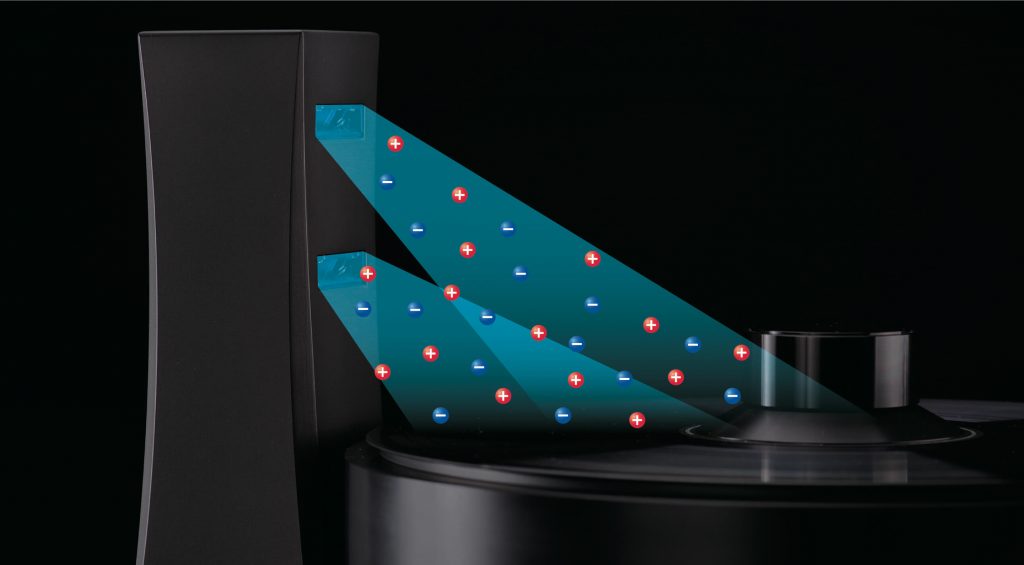
ION-001 operational illustration courtesy of DS Audio
Furthermore, there are two ion generators, one lower and closer to the LP, the other higher in the tower to provide destat action for the inner album and over to the tonearm/cartridge. This assures that the entire playback system is in range of the ionic fields.
It was immediately apparent to me that this approach provided continuous ionizing action, keeping any buildup of muddiness from happening throughout the playback of an LP. In every case, I found that I was able to rely on the ION-001 to help bring out the greatest level of clarity that I've heard. And given the transparency/quickness of the DS Master1, this was vital.
So much so that I would say that if you purchase the DS Master1, you should definitely purchase the ION-001 to go with it. At an MSRP of $1800, this is an essential complement to the DS Master1, and frankly, would benefit any other turntable system that allows for it to be placed properly.
Again: serious about LPs? Check out the ION-001.
You can thank me later.
Conclusions
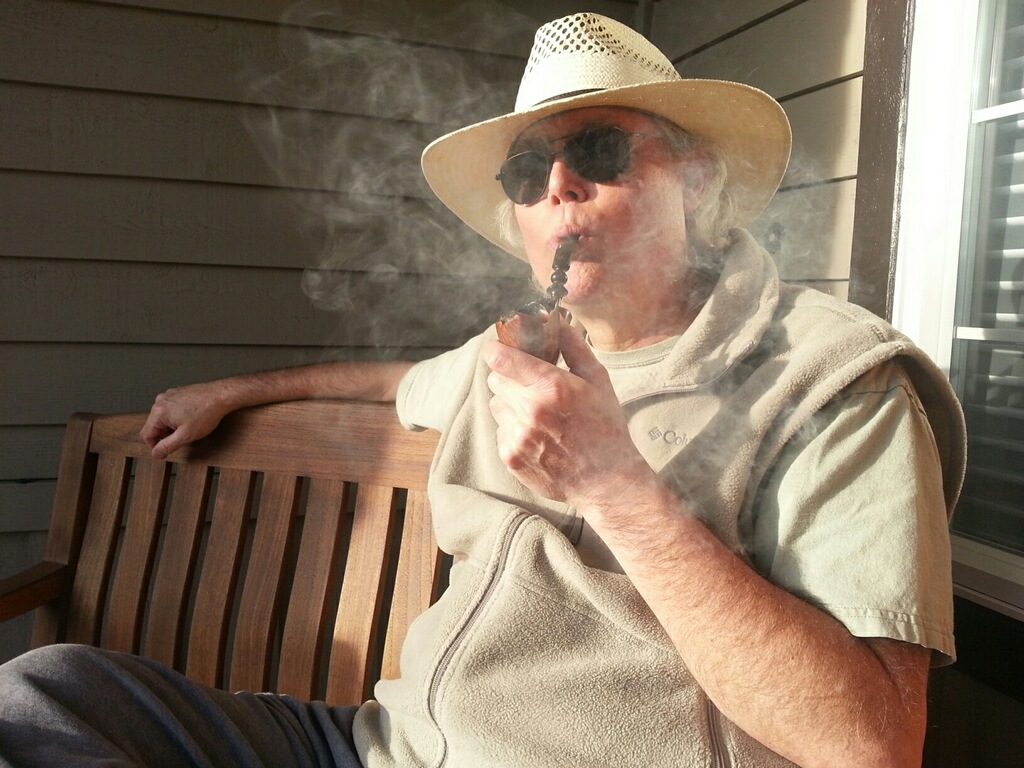
I suppose that I could go on and on about finding a revelation around every corner with this NVS/Tosca/DS Master1 turntable system…about being astonished and completely amazed at the utter transparency, clarity, lightning-like quickness, along with the utter silence of the background…but I hope I've already made that obvious.
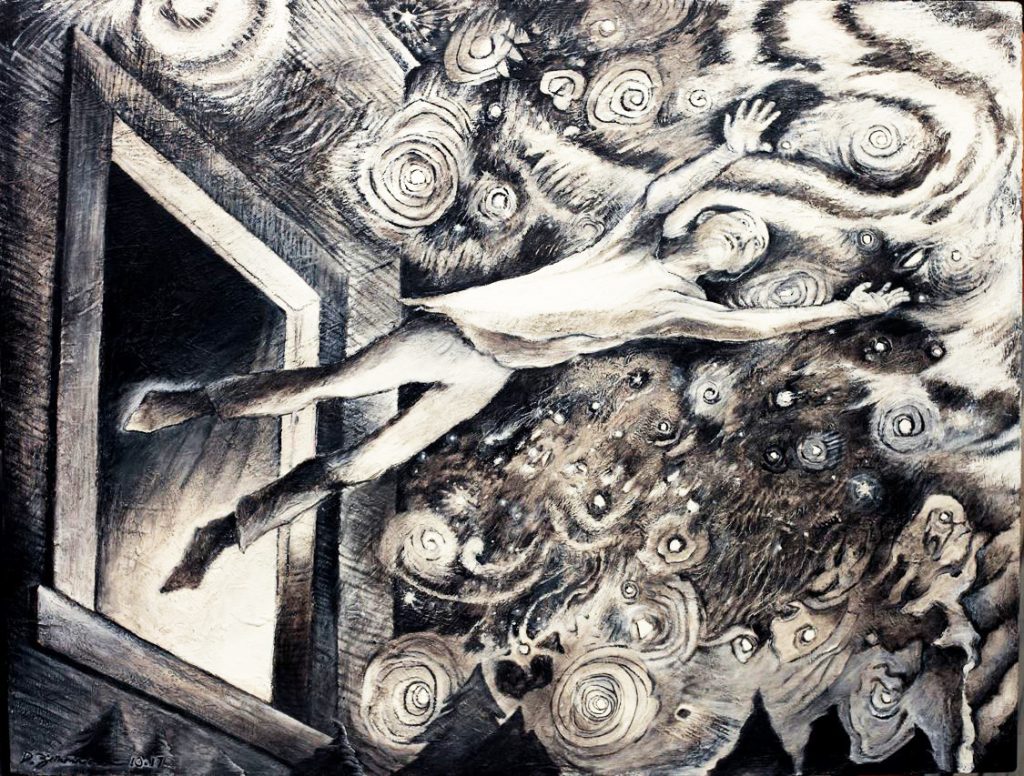
"Flying" (painting by Dan Zimmerman)
There's no reason to hold back: The NVS/Tosca/DS Audio DS Master1 combination is simply extraordinary, a peak achievement by all involved, and a monumental example of audio synergy. Up until now, it's quite unique in my experience.
The combination of materials science and the precise NVS computer-controlled direct drive, the materials science, painstaking design, and control of the Tosca gimbal mount, and the materials science and optical transmission of the DS Master1 – working in divine symbiosis—are producing the most transparent, detailed, crystalline, and truly stunning LP playback that I know of. Grooves disappear; tape emerges. Musicality, nuance, soundstaging, imaging…all embrace. And this is evident with both the Raidho TD 4.2s and the VIVID GIYAs; both reveal the same character in this turntable system.
To this point in time, the only other turntable system in my experience anywhere near this stellar level is the Walker Audio Proscenium Black Diamond Level V with all of the latest upgrades. (Note that Walker Audio has just released the huge upgrade set to take the Black Diamond Level V up to Level VI. We hope to have Walker Audio's Level VI installed here later in the year, to assess the major leap forward that Lloyd claims.)
In all fairness, there are other turntable systems that I know have terrific reputations, and that haven't yet experienced. For example, the KRONOS Pro LE has come light years since it was here a few years back. Louis Desjardin has added the SCPS Power Supply, his tube-based phono amp, and his new dedicated rack system. Paired with a state-of-the-art cartridge…several come to mind…this would be another major contender.
And sometime in August, the Dohmann Audio Helix Two is scheduled to arrive here. (For those needing a jog to the memory, Mark Dohmann is the design genius behind the Continuum line of turntables.) While not the Helix One, it looks quite impressive…we'll see how far into the highest level of the august it might ascend here.
Nevertheless, with the NVS/Tosca/DS Master1 I was shocked and amazed: Groove noise has been reduced to the vanishing point. In fact, I have to wonder how much of what is called "groove noise" is actually some other shortfall in an LP playback system. (I first began to wonder about this when we installed the Soundstream Hyperion MI cartridge…the famous "cactus needle" cartridge…on our Walker Audio Proscenium Black Diamond Level V a few years back. Its ability to cancel echoes back along the stylus, together with reduced mass in its moving iron (MI) design startled me.)
If you think that you know your LPs, think again! The NVS/Tosca/DS Master1 impressed me again and again by bringing out treasures hidden in the grooves.

The result is really obvious to me, and to others who have heard this turntable system in our listening room: the combination of the Wave Kinetics NVS turntable, the Durand Tosca tonearm, and the DS Audio DS Master1 optical cartridge/EQ phono is truly revolutionary breakthrough in analog LP playback.
After many months of extended evaluation, I can say that there is no aspect of the performance of this turntable system that I've been able to fault. None. Zero, zip, nada. And I'm pretty bloody hard to impress. This is front-rank, top o' the heap performance, amigos.
And without sounding like I'm issuing a cliché about it, I was so highly impressed with the DS Audio DS Master1 that I made arrangements to purchase it as a major reference component for my future review work at PF Central. I just can't stand to see it leave....
(But then again, I'll have to check into the DS Audio Grand Master, eh?)
My highest, heartiest recommendation for these products!
Wave Kinetics NVS Reference Direct-Drive Turntable
Current Retail: $45,000
Blue Light Audio
Jonathan Tinn
503.868.0500
Durand Tonearms Tosca Gimbal Tonearm
Retail: $15,500
DS Audio DS Master 1
Retail: call for current pricing
Musical Surroundings
Garth Leerer
510.547.5006
Photographic credits as indicated. Paintings and drawings by Dan Zimmerman, except Alice in Wonderland drawings, by Sir John Tenniel, in the public domain.






